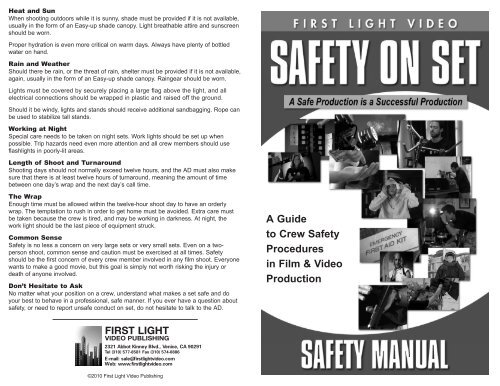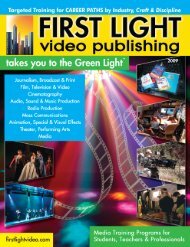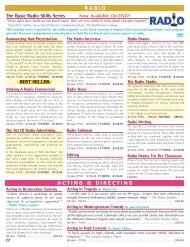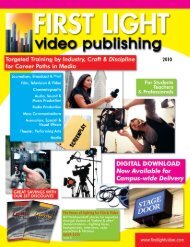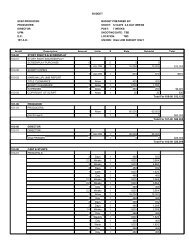to download Safety Manual & Checklist - First Light Video
to download Safety Manual & Checklist - First Light Video
to download Safety Manual & Checklist - First Light Video
Create successful ePaper yourself
Turn your PDF publications into a flip-book with our unique Google optimized e-Paper software.
Heat and Sun<br />
When shooting outdoors while it is sunny, shade must be provided if it is not available,<br />
usually in the form of an Easy-up shade canopy. <strong>Light</strong> breathable attire and sunscreen<br />
should be worn.<br />
Proper hydration is even more critical on warm days. Always have plenty of bottled<br />
water on hand.<br />
Rain and Weather<br />
Should there be rain, or the threat of rain, shelter must be provided if it is not available,<br />
again, usually in the form of an Easy-up shade canopy. Raingear should be worn.<br />
<strong>Light</strong>s must be covered by securely placing a large flag above the light, and all<br />
electrical connections should be wrapped in plastic and raised off the ground.<br />
Should it be windy, lights and stands should receive additional sandbagging. Rope can<br />
be used <strong>to</strong> stabilize tall stands.<br />
Working at Night<br />
Special care needs <strong>to</strong> be taken on night sets. Work lights should be set up when<br />
possible. Trip hazards need even more attention and all crew members should use<br />
flashlights in poorly-lit areas.<br />
Length of Shoot and Turnaround<br />
Shooting days should not normally exceed twelve hours, and the AD must also make<br />
sure that there is at least twelve hours of turnaround, meaning the amount of time<br />
between one day’s wrap and the next day’s call time.<br />
The Wrap<br />
Enough time must be allowed within the twelve-hour shoot day <strong>to</strong> have an orderly<br />
wrap. The temptation <strong>to</strong> rush in order <strong>to</strong> get home must be avoided. Extra care must<br />
be taken because the crew is tired, and may be working in darkness. At night, the<br />
work light should be the last piece of equipment struck.<br />
Common Sense<br />
<strong>Safety</strong> is no less a concern on very large sets or very small sets. Even on a twoperson<br />
shoot, common sense and caution must be exercised at all times. <strong>Safety</strong><br />
should be the first concern of every crew member involved in any film shoot. Everyone<br />
wants <strong>to</strong> make a good movie, but this goal is simply not worth risking the injury or<br />
death of anyone involved.<br />
Don’t Hesitate <strong>to</strong> Ask<br />
No matter what your position on a crew, understand what makes a set safe and do<br />
your best <strong>to</strong> behave in a professional, safe manner. If you ever have a question about<br />
safety, or need <strong>to</strong> report unsafe conduct on set, do not hesitate <strong>to</strong> talk <strong>to</strong> the AD.<br />
FIRST LIGHT<br />
VIDEO PUBLISHING<br />
2321 Abbot Kinney Blvd., Venice, CA 90291<br />
Tel (310) 577-8581 Fax (310) 574-0886<br />
E-mail: sale@firstlightvideo.com<br />
Web: www.firstlightvideo.com<br />
©2010 <strong>First</strong> <strong>Light</strong> <strong>Video</strong> Publishing<br />
A Guide<br />
<strong>to</strong> Crew <strong>Safety</strong><br />
Procedures<br />
in Film & <strong>Video</strong><br />
Production
<strong>Safety</strong> on Set<br />
<strong>Safety</strong> should be the first concern of every crew member involved in a film shoot. The<br />
equipment used in production can be particularly dangerous and the haste and improvisation<br />
which are in the very nature of the filmmaking process puts individuals at even<br />
greater risk unless they are conscientious of safety at every moment. Unfortunately,<br />
failure <strong>to</strong> observe safety policies results in serious injury and even the death of crew<br />
members all <strong>to</strong>o often. On the other hand, crew members who practice good safety<br />
procedures not only keep themselves and their fellow crew members safe, but also<br />
develop strong reputations for professionalism.<br />
Preparation<br />
<strong>Safety</strong> begins long before the shooting day. It is the responsibility of each crew member<br />
<strong>to</strong> educate themselves about safety and <strong>to</strong> arrive on set on time, well rested, and healthy.<br />
The Assistant Direc<strong>to</strong>r<br />
The AD, or Assistant Direc<strong>to</strong>r, is the primary safety officer on the set, and this responsibility<br />
takes precedence above all the other things that the <strong>First</strong> Assistant Direc<strong>to</strong>r<br />
does. The AD is responsible for the safe conduct of everyone involved in the production<br />
and will inform the crew about and enforce appropriate safety precautions. Any<br />
safety concerns should immediately be brought <strong>to</strong> the attention of the <strong>First</strong> Assistant<br />
Direc<strong>to</strong>r.<br />
The <strong>First</strong> Assistant Direc<strong>to</strong>r has the sole authority <strong>to</strong> shut the production down if there<br />
is ever any indication, large or small, that the safety of anyone on the crew for any reason<br />
appears <strong>to</strong> be in jeopardy.<br />
No one else on the crew, not the Direc<strong>to</strong>r and not the Producer, has the authority <strong>to</strong><br />
make the decision of whether or not a situation is safe enough <strong>to</strong> shoot. The <strong>First</strong><br />
Assistant Direc<strong>to</strong>r is solely responsible for making that determination, and must always<br />
err on the side of caution.<br />
The <strong>Safety</strong> Meeting<br />
The AD’s first job at the beginning of every shooting day is <strong>to</strong> conduct a safety meeting<br />
with the entire crew present. New and returning crew members must be informed on a<br />
daily basis of the safety precautions for that day’s shoot, including the locations of fire<br />
extinguishers, emergency exits, and the first aid kit, as well as any special issues pertaining<br />
<strong>to</strong> that day’s shooting such as stunts <strong>to</strong> be performed or particularly hazardous<br />
rigging.<br />
2<br />
Proper Attire<br />
The AD also checks that all crew members are in proper attire. It is particularly important<br />
that footwear be sturdy sneakers or boots. Sandals or high-heeled shoes of any<br />
kind are not permissible.<br />
The AD also checks that all crew members wear well-fitting clothing that is appropriate<br />
<strong>to</strong> the weather, thin if it is hot, layered if it is cold, and waterproof if it is wet. No clothing<br />
should have excessive fringe or any loose pieces that could possibly get caught in<br />
equipment.<br />
Crew members are responsible for bringing alternate clothing <strong>to</strong> change in<strong>to</strong> should<br />
weather conditions change unexpectedly.<br />
Working with an Equipment Truck<br />
Particular care must be taken working around trucks. Use at least one spotter when<br />
maneuvering a truck in close quarters.<br />
The contents of any truck may have shifted during travel. The door or doors should be<br />
opened slowly so that nothing can tumble out on<strong>to</strong> a crew member.<br />
There is enough power in a lift gate <strong>to</strong> cause serious injury. Operation of the gate<br />
should be performed by one crew member at a time. The crew member operating the<br />
lift gate should always yell out a warning of “going up” or “going down” <strong>to</strong> alert nearby<br />
crew members <strong>to</strong> stay back from the moving lift gate. Crew members not operating the<br />
lift gate should stay at least five feet away during operation.<br />
Moving Equipment<br />
Move only an amount of equipment you can handle. Avoid carrying anything that could<br />
be moved on a cart. Use extra people <strong>to</strong> move large loads and be careful moving<br />
through narrow passages.<br />
Power Distribution<br />
The Best Boy Electric is responsible for all power distribution from on-set lighting <strong>to</strong><br />
extension cords for craft services.<br />
Cables should be run <strong>to</strong>gether out of foot traffic areas as much as possible. When<br />
cables must cross any area where they could present a tripping hazard for the rest of<br />
the crew, they must be secured with tape, heavy carpet, or rubber matting.<br />
When using power on location, particular care must be taken not <strong>to</strong> overload circuits.<br />
In any case, only the Gaffer, the Best Boy Electric or an Electrician should ever plug in<br />
any cable or light.<br />
3
Stands and Rigging<br />
The Grips are responsible for all rigging, meaning anything that needs <strong>to</strong> be hung or<br />
put on a stand. This includes the setting of light stands. When carrying a stand, the<br />
warning “points coming through” should be yelled out so crew members can move out<br />
of the way of the possible hazard. All stands in use on the set must be sand-bagged<br />
according <strong>to</strong> their load or precariousness of their position.<br />
C-stands must be set correctly. A C-stand’s arm is designed <strong>to</strong> extend over the knuckle<br />
with the load on the side <strong>to</strong>ward which the knuckle tightens. This way, if the load forces<br />
the arm <strong>to</strong> slip, it will actually tighten and s<strong>to</strong>p. If the rear of the C-Stand arm extends<br />
out beyond the base, a marker should be attached <strong>to</strong> it so that it can clearly be seen.<br />
This is true of any equipment or prop on set which sticks out and is particularly critical<br />
if something sticks out at eye-level.<br />
Dollies<br />
Grips are also responsible for the dolly. Once dolly tracks have been set, the crew<br />
must be careful not <strong>to</strong> trip on the tracks.<br />
Heavy dollies should not be lifted, but ramped on<strong>to</strong> their tracks with wedges. Once on<br />
the track, the dolly should be prevented from rolling off the track with clamps<br />
The Dolly Grip is the only crew member permitted <strong>to</strong> operate the dolly. Except during<br />
an actual take, the dolly grip must always warn those on and around the dolly before<br />
moving the dolly, yelling “dolly moves!” or “boom going up!” Crew members must<br />
always let the dolly group know their intention <strong>to</strong> mount or dismount the dolly before<br />
doing so, usually by saying “stepping on” or “stepping off”.<br />
Nutrition and Hydration<br />
Food and drinks should be available <strong>to</strong> crew members throughout the entire shoot.<br />
Craft services keeps a crew happy, but more importantly, crew members who lack<br />
energy or focus are a hazard on set.<br />
Snacks should include fruits and vegetables as well as snack bars and candy bars.<br />
Drinks should offer both caffeinated and decaffeinated options.<br />
Working with Talent<br />
Particular care must be taken with talent. Ac<strong>to</strong>rs should not be expected <strong>to</strong> be as<br />
aware of the possible hazards on a set as crew members. It is the AD’s responsibility<br />
<strong>to</strong> get the ac<strong>to</strong>rs <strong>to</strong> the set and make them aware of any hazards.<br />
If child ac<strong>to</strong>rs or animals are on set, they must have a crew member assigned <strong>to</strong> watch<br />
them at all times. For Advanced Productions, a Studio Teacher must be hired anytime<br />
a child ac<strong>to</strong>r is on set.<br />
During the Shoot<br />
As shooting begins, the entire crew needs <strong>to</strong> stay aware of possible hazards. Any possible<br />
safety concern should be reported <strong>to</strong> the AD promptly.<br />
Watch out for burning smells, trip hazards, clear paths <strong>to</strong> fire exits, damaged equipment,<br />
or unsafe behavior by crew members or talent.<br />
Late arriving crew members must be briefed individually on safety by the AD.<br />
4<br />
Fire, Stunts, and Firearms<br />
Candles and cigarettes should be handled with great care on a set. Any larger fire<br />
used on set, even a large group of candles, must be supervised by a paid Fire<br />
Marshal.<br />
All stunts should be planned by a professional. Crew members need <strong>to</strong> be made<br />
aware of all aspects of any stunt before it is executed, and should watch for related<br />
hazards.<br />
If weapons of any kind, including guns, swords, and knives are <strong>to</strong> be used on a production,<br />
local law enforcement must be notified, even if the weapons are non-functioning<br />
replicas <strong>to</strong> be used on a closed set.<br />
The use of functioning firearms, even with blanks, should be avoided. Remember, realistic<br />
muzzle flash can very easily be added in post. Functioning firearms must be handled<br />
by a professional. The weapons specialist must only allow the ac<strong>to</strong>r whose part<br />
requires handling the weapon <strong>to</strong> handle the weapon during actual filming, and no one<br />
else should ever handle the weapon. When not in use, weapons should be s<strong>to</strong>red in a<br />
locked location. This goes for replicas or functioning firearms.<br />
Driving Shots<br />
Any shot sequences that involve moving vehicles must be approved planned for in<br />
advanced in a way that assures their safety. A process trailer should be used in cases<br />
where ac<strong>to</strong>rs cannot safely operate a mo<strong>to</strong>r vehicle at the same time they are focused<br />
on delivering a performance. Local law enforcement must be made aware of any situations<br />
involving the shooting of moving vehicles on public streets and in some case may<br />
need <strong>to</strong> restrict traffic in the shooting area.<br />
Meal Breaks<br />
A meal must always be served no more than six hours after crew call. All meals should<br />
be nutritionally balanced, and enough must be provided for the entire crew and cast.<br />
Everyone in the cast and crew should get at least half an hour <strong>to</strong> eat.<br />
Company Moves<br />
Should it be necessary <strong>to</strong> change locations in the middle of a shooting day, the company<br />
move must be handled carefully in spite of the temptation <strong>to</strong> rush <strong>to</strong> the next location.<br />
A safety meeting must be held at the new location before filming resumes.<br />
Even for a short move, all equipment should be s<strong>to</strong>wed securely in the production<br />
vehicles.<br />
Shooting Outdoors<br />
Film shoots always attract the curious. Particularly when outside, the crew needs <strong>to</strong><br />
watch out for individuals who are not part of the film shoot and keep them clear of all<br />
equipment and the shooting area in general. Report anyone who does not belong on<br />
the set <strong>to</strong> the AD.<br />
Shooting should not occur on public or private roads open <strong>to</strong> traffic. Contact local law<br />
enforcement or the property’s owners <strong>to</strong> close the area <strong>to</strong> traffic.<br />
Under no circumstances should lights or rigging of any kind be set up anywhere near<br />
power lines or overhead lines of any kind.<br />
5


